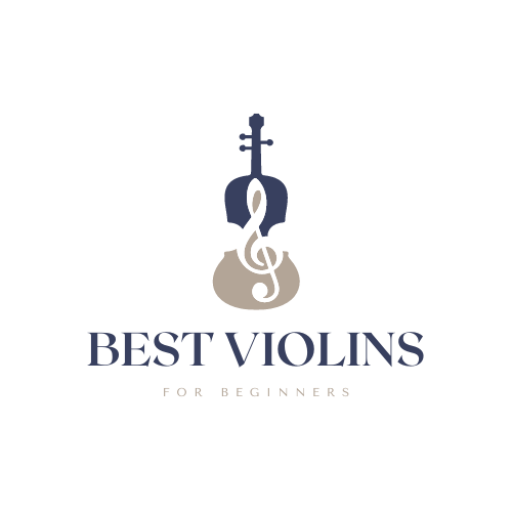The Best Violins for Students: A Comprehensive Guide to Finding Your Perfect Match
Much like a sculptor shapes marble into art, choosing the right violin can greatly influence a student’s musical journey. You want an instrument that balances sound quality, comfort, and durability, but with so many options out there, how do you decide? From popular models like the Bunnel Pupil to the Cremona SV-130, each choice offers unique advantages that cater to different needs. Understanding sizing and features is just as essential, and there’s more to reflect on than you might think. Let’s explore what makes a violin truly suitable for aspiring musicians.
Bunnel Pupil Violin Outfit 3/4 Size By Kennedy Violins
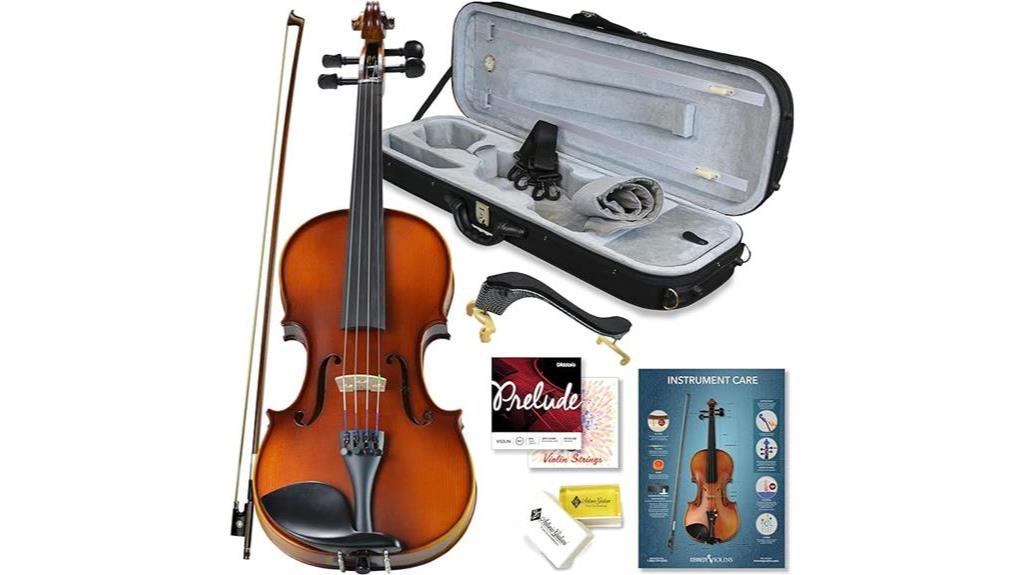
If you’re looking for a reliable and high-quality violin for your child, the Bunnel Pupil Violin Outfit 3/4 Size by Kennedy Violins is an excellent choice that combines craftsmanship and playability. This violin is handcrafted with solid maple and spruce tonewoods, ensuring a rich, warm sound that enhances your child’s student experience. The 100% genuine ebony fittings and satin oil finish not only make the Bunnel aesthetically pleasing but also durable for daily use.
One of the standout Bunnel features is the complete outfit, which includes everything your child needs to get started. You’ll find a Giuliani Brazilwood Bow, rosin, D’Addario Prelude strings, a sturdy Portland oblong case, and even a shoulder rest. This thoughtful inclusion allows your child to focus on learning without the hassle of purchasing additional accessories.
When it comes to quality assurance, the Bunnel Pupil is assembled and quality-checked in the USA, providing peace of mind for parents. With a lifetime warranty and a 45-day money-back guarantee, you can feel confident in your investment.
Customers consistently rate the Bunnel Pupil with an impressive 4.7 out of 5 stars, praising its excellent quality and sound. Many appreciate the violin’s readiness to play upon arrival, making it an ideal choice for budding musicians. By choosing the Bunnel Pupil, you’re setting your child up for a successful and enjoyable musical journey.
Stentor, 4-String Violin, Brown,Red (1500 4/4)
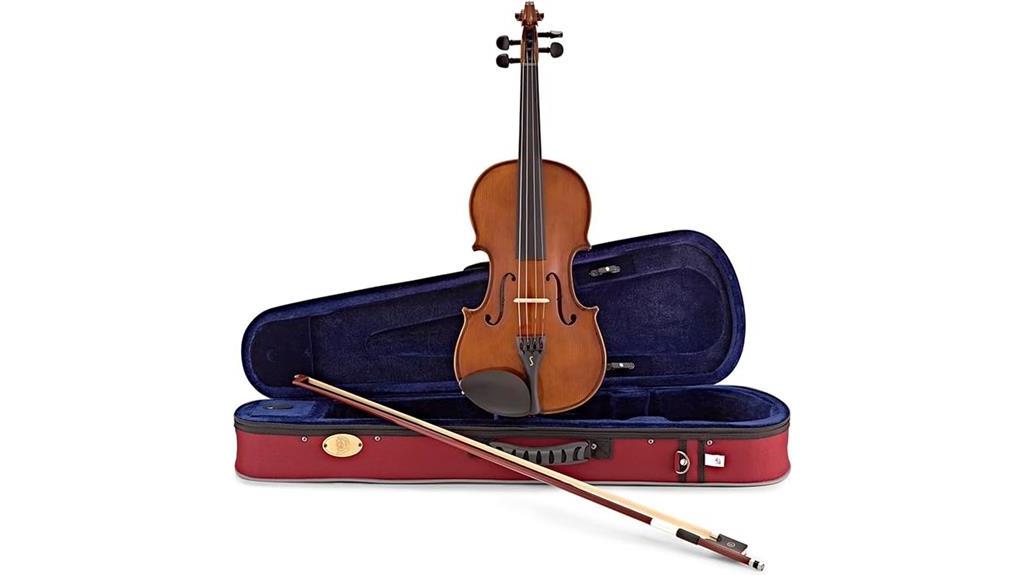
For students seeking a reliable and well-crafted instrument, the Stentor 4-String Violin (1500 4/4) offers a solid option that balances quality and affordability. This violin features a fine-grained solid spruce top and a solid maple back, guaranteeing durability and a rich tone. With a polished warm brown lacquer finish and full ebony fittings, its aesthetics are as appealing as its sound.
Designed specifically for student playability, the Stentor violin provides an excellent learning experience. You’ll find it easy to handle, thanks to its lightweight design of just 3.1 pounds and dimensions that are comfortable for young musicians. The included octagonal wood horsehair bow and sturdy canvas case give you everything you need to start your journey in music.
While the Stentor comes with Red Label strings that are adequate for beginners, you might consider upgrading to synthetic core strings for enhanced tonal quality as you progress. This violin requires proper setup—pay attention to peg box alignment and soundpost placement—to guarantee you get the best performance. Regular tuning is also essential, as new strings may stretch initially.
Cremona SV-130 Premier Novice Violin Outfit – 4/4 Size,Traditional Brown
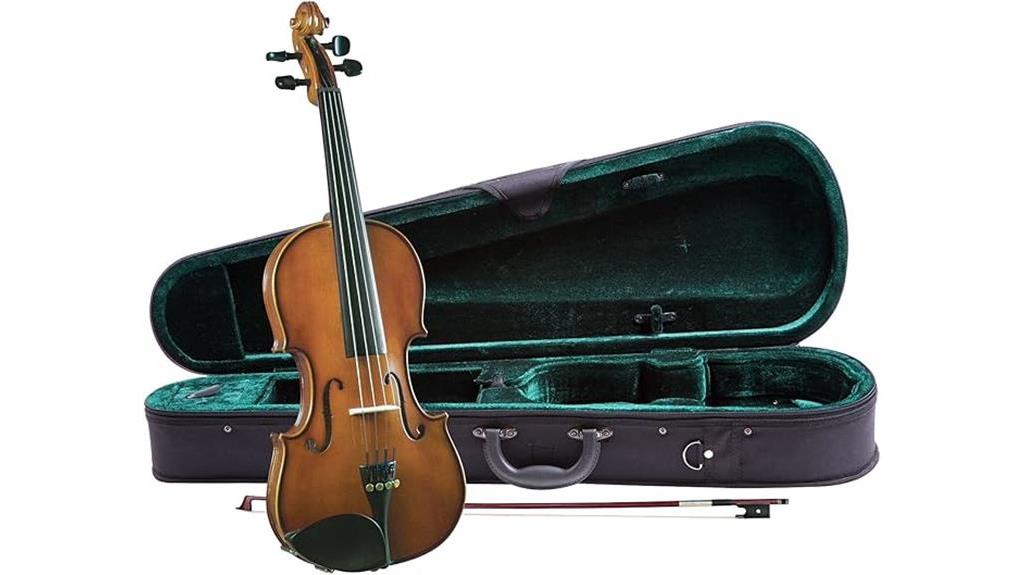
Looking for a reliable violin that’s perfect for beginners? The Cremona SV-130 Premier Novice Violin Outfit is an excellent choice, combining quality craftsmanship with student-friendly features. With over ten years as a top-selling novice violin, it’s designed specifically for student musicians like you.
This violin boasts Cremona craftsmanship, featuring a hand-carved solid spruce top and solid maple back and sides. These materials enhance sound quality, producing a deep, rich tone that’s essential for your novice performance. The lightweight design makes it easy to handle, ensuring you can play comfortably during practice or lessons.
The SV-130 comes equipped with US-made D’Addario Prelude strings, favored by educators for their reliability and sound. Swiss-style ebony pegs provide tuning stability, while the low-profile chinrest enhances comfort. You’ll appreciate the well-balanced bow, crafted from horsehair and Brazilwood, which promotes ease of playing.
Setting up your new violin is straightforward. It arrives professionally set up, with the bridge pre-installed, so you can focus on learning. Even novice players will find it easy to tune, thanks to the four smooth fine tuners on the lightweight composite tailpiece.
While there may be minor finish imperfections, the overall quality and sound performance far outweigh any drawbacks. Often priced competitively, the Cremona SV-130 is not just a purchase; it’s an investment in your musical journey. You’ll find it’s perfect for both learning and practice, with room to grow as you advance.
Vangoa Electric Violin 4/4 Full Size Silent Violin Set for Beginner Adults Teens
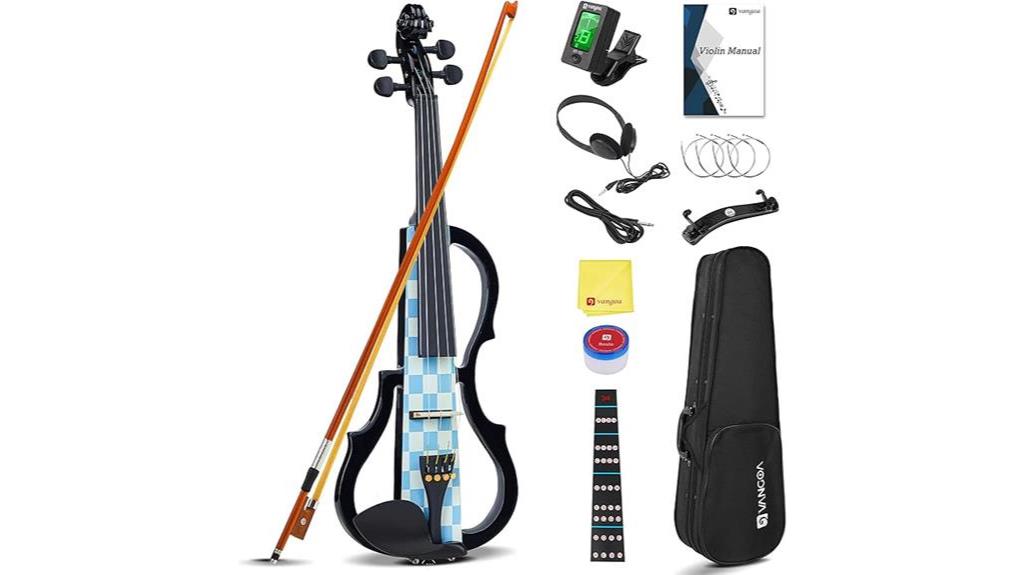
The Vangoa Electric Violin 4/4 Full Size Silent Violin Set offers a modern alternative for beginner adults and teens seeking a versatile instrument that allows for quiet practice while maintaining a stylish appeal. This electric violin not only looks fantastic with its unique Vichy pattern but also provides a comfortable experience for extended play.
Here are some key Vangoa features that enhance your beginner experiences:
- Quiet Practice: Play without disturbing others, making it perfect for late-night sessions.
- User-Friendly Controls: Easily manage volume and tone without accidental adjustments during performances.
- Lightweight Design: The ergonomic shape guarantees comfort, especially for those just starting out.
- Complete Set: Comes with essential accessories, including a shoulder pad, extra strings, and headphones, so you’re ready to play right away.
- Decent Sound Quality: While it may not match high-end acoustics, the sound improves considerably with quality headphones.
As a beginner, you may find the Vangoa Electric Violin to be an excellent fit for your practice needs. Many users appreciate its quietness and included accessories, making learning more accessible and enjoyable. Just keep in mind that tuning stability can vary, and you might want to upgrade some accessories to enhance your experience. With the Vangoa, you’re equipped to explore the world of music with confidence.
Eastar Violin 4/4 Full Size for Adults, Violin Set for Beginners with Hard Case
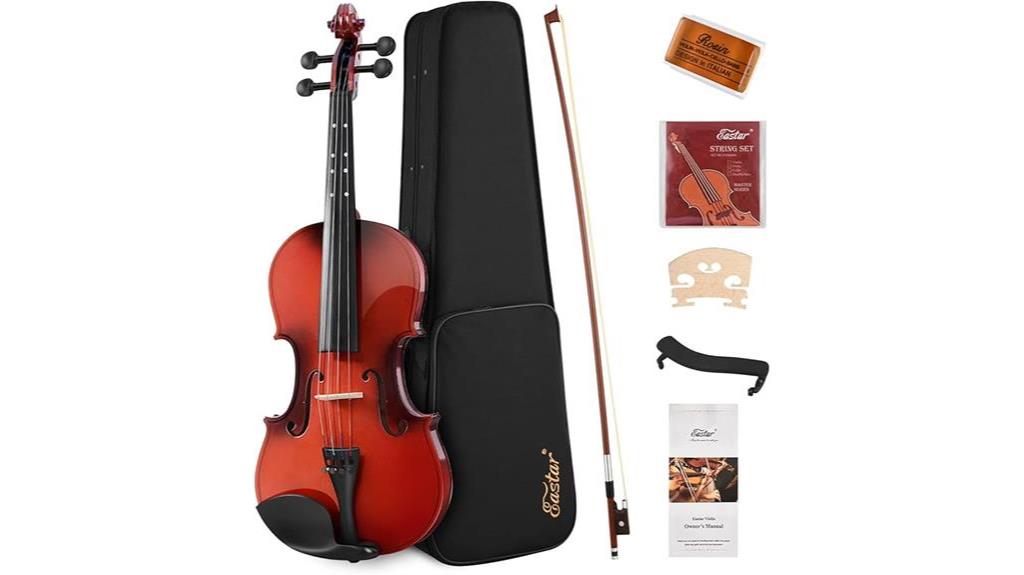
backboard, and a pear-wood fingerboard, ensuring a beautiful sound as you practice. One of the standout Eastar Violin features is its user-friendly design, including integrated fine-tuning tuners that make it easy to achieve the perfect pitch.
As a beginner, you’ll appreciate the included beginner violin accessories, such as the Mongolian horse hair bow, rosin, shoulder rest, and extra strings. These essentials simplify your initial setup and help you focus on learning. While you’ll need to install the bridge and tighten the strings upon arrival, there are plenty of tutorials available to guide you through this process.
The Eastar Violin has garnered positive feedback for its sound quality and durability, though some users have reported minor issues with certain components. It’s important to be patient during the initial tuning phase, as strings can take time to settle.
Violin Size Selection
Choosing the right violin size is essential for your comfort and success. You’ll want to take into account your age and physical characteristics to find the best fit. Let’s explore how to make the right selection to set you up for a rewarding playing experience.
Determining the appropriate violin size based on the student’s age and physical characteristics
Selecting the right violin size is essential for ensuring comfort and ease of play, especially as you take into account the student’s age and physical characteristics. Using the violin sizing guidelines, you can help your student find the perfect fit, which is vital for their learning experience.
Here are some key points to take into account:
- Age: Younger students typically require smaller violins.
- Height: Measure the student’s arm length to determine the best size.
- Weight: Take into account the student’s strength; a heavier violin can be cumbersome.
- Hand size: Smaller hands may struggle with larger instruments, affecting technique.
- Growth: Keep in mind that students grow quickly; choose a size that allows for some future adjustment.
Factors to consider
When determining the right violin size, several factors come into play that can considerably influence a student’s comfort and ability to play effectively. First, you’ll want to measure your child’s arm length. A proper fit allows them to hold the violin comfortably and reach the fingerboard without strain.
Next, consider the quality of the bow. A well-made bow enhances your child’s playing experience by providing better control and sound projection. If the bow isn’t up to par, even a good violin won’t reach its full potential.
Also, think about the overall weight of the violin. A lightweight instrument can help younger students maintain proper posture and avoid fatigue during practice.
Entry-Level Violin Models
Exploring entry-level violin models can be an exciting journey, as these instruments are designed to provide a solid foundation for your musical development without overwhelming your budget. As a beginner, you’ll want a violin that’s not only affordable but also durable and easy to play. Here are some key aspects to take into account when selecting an entry-level violin:
- Material Quality: Look for violins made from solid wood, as they produce better sound than laminated options.
- Size Matters: Confirm the violin is the right size for you. A properly sized instrument will make playing easier and more enjoyable.
- Setup: A well-set-up violin can greatly enhance playability. Check if the bridge, strings, and sound post are correctly positioned.
- Bow Selection: When choosing a violin bow, opt for a bow that complements your instrument. A good bow is essential for producing a clear sound.
- Violin Maintenance Tips: Regular maintenance is key. Learn how to properly clean your violin, change strings, and store it to keep it in top shape.
Considerations for Purchasing
When you’re ready to purchase a violin, it’s essential to take into account your budget and explore financing options that work for you. Don’t hesitate to seek professional advice to guarantee you’re making an informed choice. Also, remember to evaluate key factors when testing different violins to find the perfect fit for your needs.
Budgeting and financing options
Budgeting wisely for your violin purchase is essential to guarantee you invest in an instrument that meets your needs without breaking the bank. Start by determining your budget and exploring all available options. Consider these tips to help you in your decision-making process:
- Research Scholarships Options: Many schools and music organizations offer scholarships. These can greatly reduce your costs.
- Explore Rental Programs: Renting a violin can be a cost-effective way to begin your musical journey, allowing you to try different instruments before committing to a purchase.
- Set Aside a Fund: Create a dedicated savings fund for your violin. Saving gradually can help make this investment more manageable.
- Buy Used Instruments: Look for quality used violins. You can often find great deals on instruments that still have plenty of life in them.
- Consider Accessories: Don’t forget to budget for essential accessories like a bow, case, and rosin. These will enhance your playing experience and guarantee your instrument stays protected.
Obtaining professional advice and guidance
Before making a purchase, it’s essential to seek professional advice to guarantee you choose a violin that suits your playing style and skill level. Start by talking to your music teacher. They can provide invaluable insights and recommendations based on your progress and preferences. Teacher recommendations are often tailored to your individual needs, helping you avoid beginner pitfalls.
Next, consider expert consultations at local music shops or online retailers. Many specialized shops have knowledgeable staff who can guide you through the selection process. They can help you understand the nuances between different models, materials, and brands, ensuring you find a violin that feels right in your hands.
Don’t hesitate to ask questions during these consultations. Inquire about the violin’s setup, maintenance, and any additional costs associated with accessories.
Taking the time to gather this professional advice will not only enhance your confidence in your purchase but also set you on a path toward successful playing. Remember, choosing the right violin is an investment in your musical journey, so be proactive and seek the guidance you need to make an informed decision.
Factors to evaluate when testing and selecting a violin
Testing and selecting a violin involves carefully evaluating several key factors to guarantee you find the perfect instrument for your needs. Understanding these elements will help you make an informed choice that suits your playing style and budget. Here are some vital factors to take into account:
- Sound Quality: Pay attention to how the violin resonates. A rich, full sound will encourage you to practice more.
- Build Materials: Look for violins made from quality woods like spruce for the top and maple for the back. These materials contribute to better sound and durability.
- Size: Confirm the violin fits you well. Sizes vary, and a proper fit is essential for comfort and technique.
- Weight: A heavier violin might be more challenging to handle, especially for younger students. Balance is important.
- Price: Set a budget, but remember that investing in a quality instrument can greatly enhance your learning experience.
Conclusion
Choosing the right violin can truly enhance your learning experience. Did you know that over 80% of music educators recommend starting with a quality instrument for better sound development? By selecting a well-constructed model like the Bunnel Pupil or Stentor 1500, you’re setting yourself up for success. Remember, comfort and proper sizing are just as important as sound. Don’t hesitate to explore your options—finding the perfect violin can inspire your musical journey and keep you motivated!

Lisa Maiers, a seasoned musician and dedicated music educator, brings her wealth of knowledge and passion for string instruments to the forefront in her latest guide, “Best Violins for Beginners.” With years of experience nurturing budding violinists, Lisa understands the critical role that the right instrument plays in a student’s musical journey. In this comprehensive guide, she offers invaluable insights and expert recommendations, helping beginners and their families make informed choices that foster growth, confidence, and a lifelong love of music. Whether you’re a parent seeking the perfect violin for your child or an adult embarking on a new musical adventure, Lisa’s expertise will guide you every step of the way.
